Dometic RH 430 LG, RH 440 LG User Manual
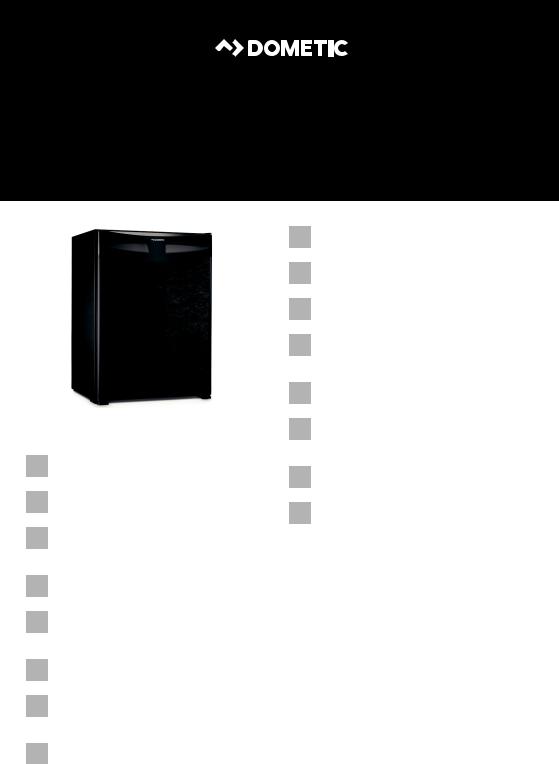
REFRIGERATION
ECOLINE
RH430LD, RH430LG, RH440LD, RH440LG, RH460LD, RH460LG
EN Minibar
Installation and Operating Manual . . . . . . . 11
DE Minibar
Montageund Bedienungsanleitung . . . . .23
FR Minibar
Instructions de montage
et de service . . . . . . . . . . . . . . . . . . . . . . . . .36
ES Minibar
Instrucciones de montaje y de uso . . . . . . .49
PT Minibar
Instruções de montagem e manual de instruções . . . . . . . . . . . . . . . . . . . . . . . . . . .62
IT Minibar
Istruzioni di montaggio e d’uso . . . . . . . . . 75
NL Minibar
Montagehandleiding en
gebruiksaanwijzing . . . . . . . . . . . . . . . . . . .88
DA Minibar
SV Minibar
Monteringsoch bruksanvisning . . . . . . . 113
NO Minibar
Monteringsog bruksanvisning . . . . . . . . 125
FI Minibaari
Asennusja käyttöohje . . . . . . . . . . . . . . . 137
RU Мини-бар
Инструкция по монтажу и эксплуатации . . . . . . . . . . . . . . . . . . . . . 149
PL Minibar
Instrukcja montażu i obsługi. . . . . . . . . . . 162
SK Minibar
Návod na montáž a uvedenie
do prevádzky. . . . . . . . . . . . . . . . . . . . . . . 175
CS Minibar
Návod k montáži a obsluze . . . . . . . . . . . 188
HU Minibár
Szerelési és használati útmutató . . . . . . . 200
Monteringsog betjeningsvejledning . . . 101
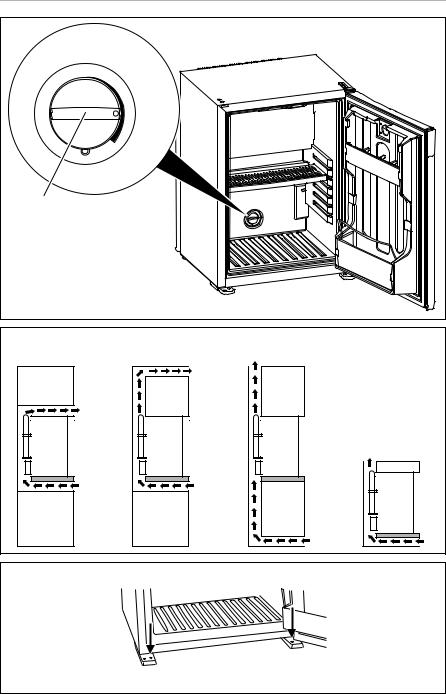
RH4xxLD, RH4xxLG |
|
|
|
|
1 |
|
|
|
|
|
1 |
|
|
|
2 |
A |
B |
C |
D |
3 |
3
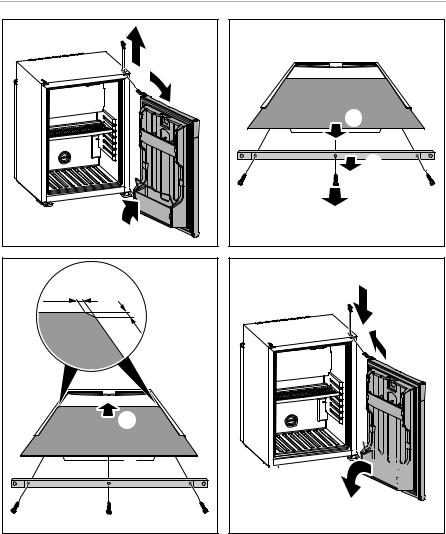
|
|
RH4xxLD, RH4xxLG |
4 |
|
5 |
|
|
1. |
|
|
2. |
|
|
3. |
|
|
2. |
|
|
1. |
|
|
3. |
6 |
|
7 |
|
5 mm |
3. |
|
|
|
|
|
2. |
1.
 2.
2. 






 1.
1. 

 3.
3.
4
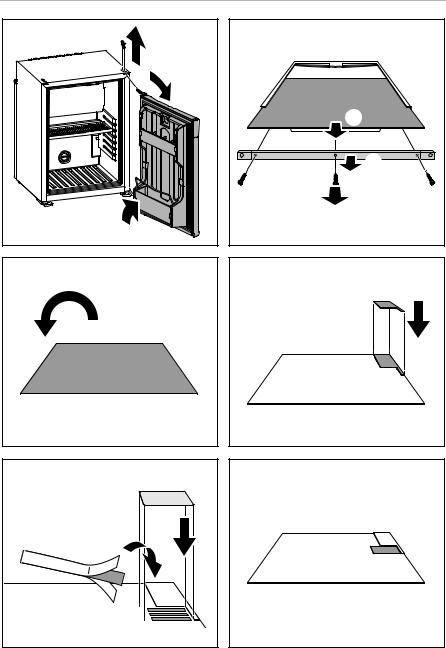
RH4xxLD, RH4xxLG |
|
8 |
9 |
|
1. |
|
2. |
|
3. |
|
2. |
|
1. |
|
3. |
0 |
a |
180° |
|
b |
|
c |
|
1. |
2. |
|
|
5
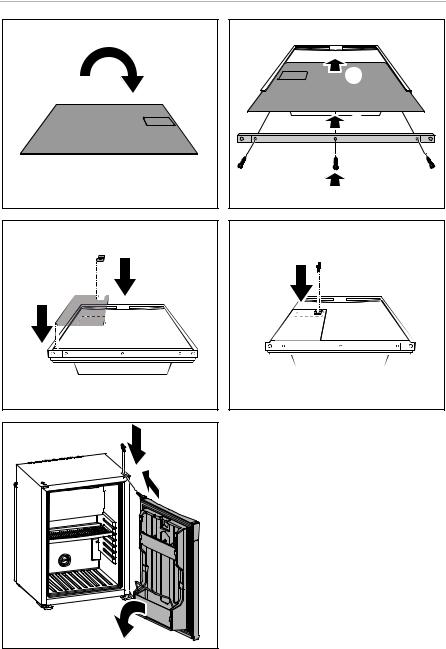
|
RH4xxLD, RH4xxLG |
d |
e |
180° |
1. |
|
2. |
|
3. |
f |
g |
|
2. |
1. |
|
h |
3. |
|
. |
6 |
|
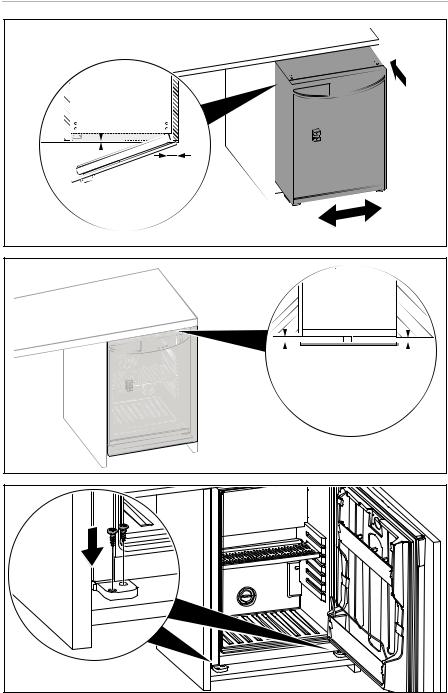
RH4xxLD, RH4xxLG |
i |
1. |
mm 10 |
40 mm |
2. |
j |
k |
7 |
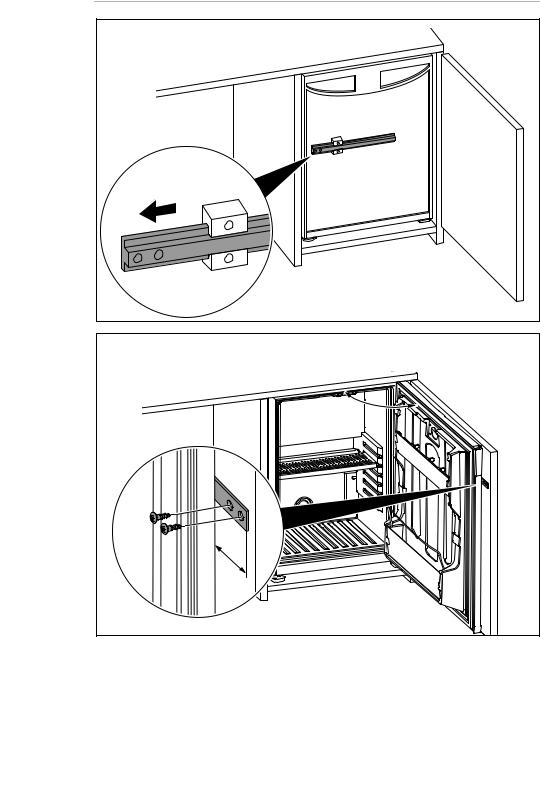
RH4xxLD, RH4xxLG |
l |
m |
90° |
80 |
mm |
8 |
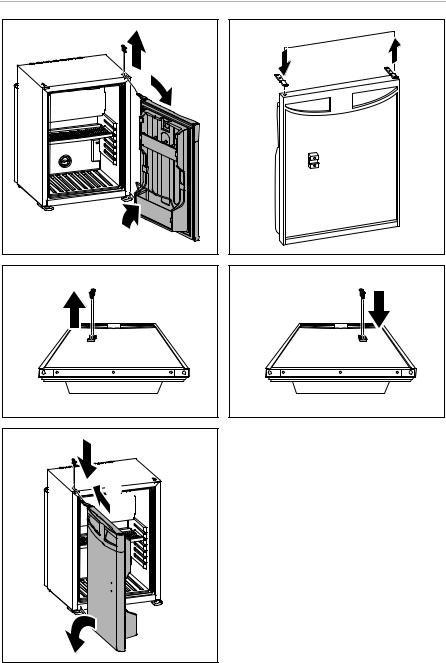
RH4xxLD, RH4xxLG |
|
n |
o |
|
1. |
|
2. |
|
3. |
p |
q |
r
3.
.



9

RH4xxLD, RH4xxLG
s
1. |
2. |
|
4.
3.
5.
6.
10

RH4xxLD, RH4xxLG |
Explanation of symbols |
Please read this manual carefully before starting the device. Keep it in a safe place for future reference. If the device is passed on to another person, this manual must be handed over to the user along with it.
The manufacturer cannot be held liable for damage resulting from improper usage or incorrect operation.
Contents |
|
|
1 |
Explanation of symbols . . . . . . . . . . . . . . . . . . . . . . . . . . . . . . . . . . . . . . . . . |
. 11 |
2 |
Safety instructions . . . . . . . . . . . . . . . . . . . . . . . . . . . . . . . . . . . . . . . . . . . . . . |
12 |
3 |
Intended use . . . . . . . . . . . . . . . . . . . . . . . . . . . . . . . . . . . . . . . . . . . . . . . . . . |
15 |
4 |
Scope of delivery . . . . . . . . . . . . . . . . . . . . . . . . . . . . . . . . . . . . . . . . . . . . . . |
15 |
5 |
Technical description . . . . . . . . . . . . . . . . . . . . . . . . . . . . . . . . . . . . . . . . . . . |
15 |
6 |
Installation . . . . . . . . . . . . . . . . . . . . . . . . . . . . . . . . . . . . . . . . . . . . . . . . . . . . |
16 |
7 |
Operation . . . . . . . . . . . . . . . . . . . . . . . . . . . . . . . . . . . . . . . . . . . . . . . . . . . . |
17 |
8 |
Cleaning and maintenance. . . . . . . . . . . . . . . . . . . . . . . . . . . . . . . . . . . . . . . |
18 |
9 |
Troubleshooting . . . . . . . . . . . . . . . . . . . . . . . . . . . . . . . . . . . . . . . . . . . . . . . |
19 |
10 |
Disposal . . . . . . . . . . . . . . . . . . . . . . . . . . . . . . . . . . . . . . . . . . . . . . . . . . . . . |
20 |
11 |
Technical data . . . . . . . . . . . . . . . . . . . . . . . . . . . . . . . . . . . . . . . . . . . . . . . . . |
21 |
1Explanation of symbols
DDANGER!
Safety instruction: Indicates a hazardous situation that, if not avoided, will result in death or serious injury.
!WARNING!
Safety instruction: Indicates a hazardous situation that, if not avoided, could result in death or serious injury.
!CAUTION!
Safety instruction: Indicates a hazardous situation that, if not avoided, could result in minor or moderate injury.
EN |
11 |
|
|
|
|

Safety instructions |
RH4xxLD, RH4xxLG |
ANOTICE!
Indicates a situation that, if not avoided, can result in property damage.
INOTE
Supplementary information for operating the product.
2Safety instructions
2.1General safety
DDANGER! Failure to obey these warnings will result in death or serious injury.
Electrocution hazard
•On boats: If the device is powered by the mains, ensure that the power supply has a residual current circuit breaker.
!WARNING! Failure to obey these warnings could result in death or serious injury.
Electrocution hazard
•Installations in washrooms and areas exposed to water, must be performed by a qualified technician.
•Do not operate the device if it is visibly damaged.
•If this device's power cable is damaged, it must be replaced by the manufacturer, customer service or a similarly qualified person in order to prevent safety hazards.
•This device may only be repaired by qualified personnel. Inadequate repairs may cause serious hazards.
Health hazard
•This device can be used by children aged from 8 years and above and persons with reduced physical, sensory or mental capabilities or lack of experience and knowledge if they have been given supervision or instruction concerning use of the device in a safe way and understand the hazards involved.
•Children shall not play with the device.
•Cleaning and user maintenance shall not be made by children without supervision.
12 |
EN |
|
RH4xxLD, RH4xxLG |
Safety instructions |
•Children aged from 3 to 8 years are allowed to load and unload refrigerating devices.
Explosion hazard
•Do not store any explosive substances, such as spray cans with propellants, in the device.
!CAUTION! Failure to obey these cautions could result in minor or moderate injury.
Risk of crushing
•Do not put your fingers into the hinge.
Health hazard
•Foodstuff may only be stored in its original packaging or in suitable containers.
ANOTICE! Damage hazard
•Check that the voltage specification on the type plate is the same as that of the power supply.
•Never pull the plug out of the socket by the connection cable.
•The device is not suitable for storing substances which are caustic or contain solvents.
•Keep the drainage outlet clean at all times.
•Do not open the refrigerant circuit under any circumstances.
•Never transport the device in a horizontal position, so that no oil can leak out of the compressor.
•Make sure that the refrigerant circuit is not damaged during transportation. The refrigerant in the refrigerant circuit is highly flammable.
In the event of any damage to the refrigerant circuit:
–Avoid naked flames and sparks.
–Air the room well.
•Set up the device in a dry location where it is protected against splashing water.
2.2Operating the device safely
DDANGER! Failure to obey these warnings will result in death or serious injury.
Electrocution hazard
• Do not touch exposed cables with your bare hands.
EN |
13 |
|
|
|
|

Safety instructions |
RH4xxLD, RH4xxLG |
!CAUTION! Failure to obey these cautions could result in minor or moderate injury.
Electrocution hazard
•Before starting the device, ensure that the power supply line and the plug are dry.
Health hazard
•Opening the door for long periods can cause significant increase of the temperature in the compartments of the device.
•Clean regularly surfaces that can come in contact with food and accessible drainage systems.
•Store raw meat and fish in suitable containers in the device, so that it is not in contact with or can drip onto other food.
•If the device is left empty for long periods:
–Switch off the device.
–Defrost the device.
–Clean and dry the device.
–Leave the door open to prevent mould developing within the device.
ANOTICE! Damage hazard
•Do not use electrical devices inside the cooling device unless they are recommended by the manufacturer for that purpose.
•Do not place it near naked flames or other heat sources (heaters, direct sunlight, gas ovens etc.)
•Danger of overheating!
Always ensure sufficient ventilation so that the heat generated during operation can dissipate. Make sure that the device is sufficiently far away from walls and other objects so that the air can circulate.
•Ensure that the ventilation vents are not covered.
•Do not fill the inner container with ice or fluid.
•Never immerse the device in water.
•Protect the device and the cable against heat and moisture.
•Make sure that foodstuffs do not touch the walls of the cooling area.
14 |
EN |
|

RH4xxLD, RH4xxLG |
Intended use |
3Intended use
The cooling device is suitable for cooling beverages and snacks.
The device is designed for use with a 220 – 240 Vw mains supply.
!CAUTION! Health hazard!
Please check if the cooling capacity of the device is suitable for storing the food or medicine you wish to cool.
4Scope of delivery
Quantity Description
1Minibar
1Installation and operating manual
5Technical description
The cooling device can cool products to a maximum of 21 °C (RH430LD, RH440LD, RH460LD only) or 18 °C (RH430LG, RH440LG, RH460LG only) under the ambient temperature and keep them cool. A grid divider can be used to separate foodstuffs, e.g. bottles and sweets.
Control element
No. in |
Description |
fig. 1, page 3 |
1Temperature controller
Defrosting function
Frost will gradually form on the cooling surfaces. To prevent this frost-formation the appliance has a function switching off the cooling unit for two hours in every
24 hours.
During the two hour defrosting phase the frost will melt and the defrost water runs into an evaporating vessel located at the bottom rear of the refrigerator. The defrost water evaporates automatically so that the vessel does not have to be emptied manually.
EN |
15 |
|
|
|
|

Installation |
RH4xxLD, RH4xxLG |
6Installation
!WARNING! Electrical shock!
Failure to obey these instructions could result in death or serious injury.
•When positioning the device, ensure the supply cord is not trapped or damaged.
•Do not locate multiple portable socket-outlets or portable power supplies at the rear of the device.
!CAUTION! Health hazard
To avoid a hazard due to instability of the device, it must be fixed in accordance with the instructions.
The cooling device is designed for free-standing installation, but it can also be installed in a built-in cabinet. To ensure satisfactory operation and maximum cooling efficiency the following installation conditions have to be fulfilled.
•The cooling device must be levelled carefully to ensure proper function.
•The clearance between the cooling device‘s back and the wall should be 20 mm or more.
•Ventilation must be provided as shown in alternatives A, B, C or D (fig. 2, page 3).
•The ventilation duct must at least measure 105 mm x the width of the cooling device.
•The entire cooling unit must project into the ventilation duct as shown (fig. 2, page 3). Other parts of the device may not project into the ventilation duct.
•Air passing through the ventilation duct must not be preheated by any source of heat.
•Ventilation grills, if used, must have openings of at least 200 cm².
•Moisture will condense on the door of the glass door version, when the ambient humidity is above 65 % in 25 °C ambient temperature.
•The cooling device must be fixed. Use screws of an appropriate length and insert them through the device feet (fig. 3, page 3).
•The socket outlet for the mains connection must be freely accessible.
6.1Changing the decorative plate
To change the decorative plate proceed as shown in fig. 4 to fig. 7 on page 4.
16 |
EN |
|

RH4xxLD, RH4xxLG |
Operation |
6.2Mounting the sliding hinge (optional)
You can mount a sliding hinge that allows the cooling device door to be opened together with the door of the built-in cabinet (fig. 8, page 5, to fig. m, page 8).
6.3Reversing the door
Reverse the door as shown in fig. n to fig. r on page 9.
For doors with a sliding hinge proceed as shown in fig. p to fig. q on page 9.
7Operation
!CAUTION! Health hazard!
Food may only be stored in its original packaging or in suitable containers.
INOTE
•Before starting your new cooling device for the first time, you should clean it inside and outside with a damp cloth for hygienic reasons (please also refer to the chapter “Cleaning and maintenance” on page 18).
•If a few drops of water form inside the cooling device after it has been cooling for a lengthy period, the cooling device is not defective. Air moisture condenses to water when the temperature in the cooling device falls. Wipe the water out with a dry cloth if necessary.
7.1Energy saving tips
•Choose a well ventilated location which is protected from direct sunlight.
•Allow warm food to cool down first before placing it in the cooling device to keep cool.
•Do not open the cooling device more often than necessary.
•Do not leave the cooling device open for longer than necessary.
EN |
17 |
|
|
|
|

Cleaning and maintenance |
RH4xxLD, RH4xxLG |
7.2Using the cooling device
ANOTICE! Risk of damage
•Ensure that the objects placed in the cooling device are suitable for cooling to the selected temperature.
•Ensure that food or liquids in glass containers are not excessively refrigerated. Liquids expand when they freeze and can therefore destroy the glass containers.
•Ensure that your cooling device is well ventilated so that any heat created can dissipate. Otherwise proper functioning cannot be ensured. It is especially important not to cover the air vents.
INOTE
If the cooling device is not in use for an extended period of time, leave the door slightly ajar to prevent unpleasant odours building up.
Place the cooling device on a firm base.
Connect the connection cable to the AC mains supply.
The cooling device starts cooling the interior.
Set the temperature controller (fig. 1 1, page 3) to the desired temperature (3 – 12 °C).
If you wish to switch the cooling device off, pull out the connection cable or ...
Rotate the temperature controller (fig. 1 1, page 3) anti-clockwise to the OFF position.
8Cleaning and maintenance
!WARNING!
Always disconnect the device from the power supply before you clean and service it.
ANOTICE! Risk of damage
•Never clean the cooling device under running water or in dish water.
•Do not use abrasive cleaning agents or hard objects during cleaning as these can damage the cooling device.
18 |
EN |
|

RH4xxLD, RH4xxLG |
Troubleshooting |
Use a soft cloth, lukewarm water and a mild detergent to clean the inside of the cooling device.
Wash out the cooling device using clean water and dry thoroughly.
At annual intervals, remove dust from the cooling aggregate at the back of the cooling device using a brush or a soft cloth.
8.1Changing the device light
!WARNING!
Always disconnect the device from the power supply before you change the device light.
The device uses a LED board as illuminant. A new LED board can be obtained from Dometic.
Change the LED light as follows: fig. s, page 10
9Troubleshooting
Problem
Device is not cooling (the cooling unit at the back of the device is cold).
Possible cause |
Suggested remedy |
The device plug is not |
Plug the device plug in. |
plugged in. |
|
|
|
No voltage present in the |
Check fuse or try using another plug |
AC voltage socket. |
socket. |
|
|
The device is in its defrostCheck again if the device is cooling
ing phase. |
after 2 hours as the defrosting phase |
|
lasts 2 hours. |
|
|
|
The electronics or the senThis can only be repaired by an author- |
||
|
sor is defective. |
ised customer services unit. |
|
|
|
|
|
|
The heating element is |
This can only be repaired by an |
|
|
defective. |
authorised repair centre. |
|
|
|
||
Device is not cooling The device is not level. |
Level the device using a spirit level. |
||
(the cooling unit at |
|
|
|
The device was only |
Let the device run for 5 to 6 hours. |
||
the back of the |
|||
switched on a short while |
|
||
device is warm). |
|
||
ago. |
|
||
|
|
||
|
|
|
|
|
The cooling unit is |
This can only be repaired by an |
|
|
defective. |
authorised repair centre. |
|
|
|
|
|
EN |
19 |
|
|
|
|

Disposal |
|
RH4xxLD, RH4xxLG |
|
|
|
Problem |
Possible cause |
Suggested remedy |
|
|
|
The devices cooling |
The cooling unit is not |
performance is poor. |
sufficiently ventilated. |
Check that the ventilation grids are not covered.
Check that device has been installed in accordance with fig. 2, page 3.
The device is exposed to |
Relocate the device. |
heat or direct sunlight. |
|
|
|
The device door does not close tightly.
Check if the door is installed correctly. An authorised repair centre can install a new door seal if necessary..
|
The device was stocked a |
Check the temperature after 5 to |
|
short while ago. |
6 hours. |
|
|
|
Frost is forming inside |
The device door does not |
Check if the door is installed correctly. |
the device. |
close tightly. |
An authorised repair centre can install |
|
|
a new door seal if necessary. |
|
|
|
10 Disposal
Place the packaging material in the appropriate recycling waste bins wherever possible.
MIf you wish to finally dispose of the product, ask your local recycling centre or specialist dealer for details about how to do this in accordance with the applicable disposal regulations.
20 |
EN |
|

RH4xxLD, RH4xxLG |
|
|
Technical data |
|
11 |
Technical data |
|
|
|
|
|
|
|
|
|
|
RH430LD |
RH430LG |
RH440LD |
|
|
|
|
|
Gross capacity: |
30 l |
40 l |
||
|
|
|
||
Connection voltage: |
220 – 240 Vw, 50/60 Hz |
|||
|
|
|
|
|
Power consumption: |
|
65 W |
|
|
|
|
|
|
|
Temperature range: |
|
+3 °C to +12 °C |
|
|
|
|
|
|
|
Category: |
|
|
2 (Cellar) |
|
|
|
|
|
|
Energy efficiency class: |
D |
F |
D |
|
|
|
|
|
|
Energy consumption |
260 |
365 |
266 |
|
(kWh/annum): |
|
|
|
|
|
|
|
|
|
Usable capacity: |
26 l |
27 l |
36 l |
|
|
|
|
|
|
Climate class: |
|
N, T |
|
|
|
|
|
|
|
Refrigerant quantity: |
|
100 g |
|
|
|
|
|
|
|
Ambient temperature: |
|
+16 °C to +32 °C |
|
|
|
|
|
|
|
Noise emission (sound power): |
|
0 dB |
|
|
|
|
|
|
|
Dimensions (W x D x H): |
384 x 410 x 522 |
384 x 420 x 522 |
401 x 446 x 554 |
|
|
|
|
|
|
Weight: |
|
13.95 kg |
16.7 kg |
15 kg |
|
|
|
|
|
Testing/certification: |
|
|
|
|
|
|
|
|
|
EN |
21 |
|
|
|
|
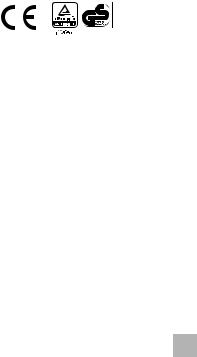
Technical data |
|
RH4xxLD, RH4xxLG |
|
|
|
|
|
|
RH440LG |
RH460LD |
RH460LG |
|
|
|
|
Gross capacity: |
40 l |
60 l |
|
|
|
|
|
Connection voltage: |
220 – 240 Vw, 50/60 Hz |
||
|
|
|
|
Power consumption: |
65 W |
80 W |
|
|
|
|
|
Temperature range: |
|
+3 °C to +12 °C |
|
|
|
|
|
Category: |
|
2 (Cellar) |
|
|
|
|
|
Energy efficiency class: |
F |
F |
G |
|
|
|
|
Energy consumption |
365 |
372 |
449 |
(kWh/annum): |
|
|
|
|
|
|
|
Usable capacity: |
37 l |
55 l |
56 l |
|
|
|
|
Climate class: |
|
N, T |
|
|
|
|
|
Refrigerant quantity: |
|
100 g |
|
|
|
|
|
Ambient temperature: |
|
+16 °C to +32 °C |
|
|
|
|
|
Noise emission (sound power): |
|
0 dB |
|
|
|
|
|
Dimensions (W x D x H): |
401 x 456 x 554 |
486 x 474 x 563 |
486 x 484 x 563 |
|
|
|
|
Weight: |
18.4 kg |
17.95 kg |
22.15 kg |
|
|
|
|
Testing/certification: |
|
|
|
|
|
|
|
22 |
EN |
|

RH4xxLD, RH4xxLG |
Erklärung der Symbole |
Bitte lesen Sie diese Anleitung vor der Inbetriebnahme sorgfältig durch und bewahren Sie sie auf. Geben Sie sie im Falle einer Weitergabe des Kühlgerätes an den Nutzer weiter.
Der Hersteller haftet nicht für Schäden, die durch nicht bestimmungsgemäßen Gebrauch oder falsche Bedienung verursacht werden.
Inhaltsverzeichnis
1 Erklärung der Symbole . . . . . . . . . . . . . . . . . . . . . . . . . . . . . . . . . . . . . . . . . 23 2 Sicherheitshinweise . . . . . . . . . . . . . . . . . . . . . . . . . . . . . . . . . . . . . . . . . . . 24 3 Bestimmungsgemäßer Gebrauch . . . . . . . . . . . . . . . . . . . . . . . . . . . . . . . . 27 4 Lieferumfang . . . . . . . . . . . . . . . . . . . . . . . . . . . . . . . . . . . . . . . . . . . . . . . . . 27 5 Technische Beschreibung . . . . . . . . . . . . . . . . . . . . . . . . . . . . . . . . . . . . . . 28 6 Montage . . . . . . . . . . . . . . . . . . . . . . . . . . . . . . . . . . . . . . . . . . . . . . . . . . . . 28 7 Bedienung. . . . . . . . . . . . . . . . . . . . . . . . . . . . . . . . . . . . . . . . . . . . . . . . . . . 30 8 Reinigung und Pflege . . . . . . . . . . . . . . . . . . . . . . . . . . . . . . . . . . . . . . . . . . .31 9 Störungsbeseitigung . . . . . . . . . . . . . . . . . . . . . . . . . . . . . . . . . . . . . . . . . . 32 10 Entsorgung . . . . . . . . . . . . . . . . . . . . . . . . . . . . . . . . . . . . . . . . . . . . . . . . . . 33 11 Technische Daten . . . . . . . . . . . . . . . . . . . . . . . . . . . . . . . . . . . . . . . . . . . . . 34
1Erklärung der Symbole
DGEFAHR!
Sicherheitshinweis auf eine Gefahrensituation, die zum Tod oder zu schwerer Verletzung führt, wenn sie nicht vermieden wird.
!WARNUNG!
Sicherheitshinweis auf eine Gefahrensituation, die zum Tod oder zu schwerer Verletzung führen kann, wenn sie nicht vermieden wird.
DE |
23 |
|
|
|
|

Sicherheitshinweise |
RH4xxLD, RH4xxLG |
!VORSICHT!
Sicherheitshinweis auf eine Gefahrensituation, die zu einer leichten oder mittelschweren Verletzung führen kann, wenn sie nicht vermieden wird.
AACHTUNG!
Hinweis auf eine Situation, die zu Sachschäden führen kann, wenn sie nicht vermieden wird.
IHINWEIS
Ergänzende Informationen zur Bedienung des Produktes.
2Sicherheitshinweise
2.1Allgemeine Sicherheit
DGEFAHR! Nichtbeachtung dieser Sicherheitshinweise führt zum Tod oder zu schweren Verletzungen.
Lebensgefahr durch Stromschlag
•Bei Booten: Sorgen Sie bei Netzbetrieb unbedingt dafür, dass Ihre Stromversorgung über einen FI-Schutzschalter abgesichert ist.
!WARNUNG! Nichtbeachtung dieser Sicherheitshinweise kann zum Tod oder zu schweren Verletzungen führen.
Lebensgefahr durch Stromschlag
•Lassen Sie Installationen in Feuchträumen und Bereichen, die Wasser ausgesetzt sind, nur vom Fachmann ausführen.
•Wenn das Gerät sichtbare Beschädigungen aufweist, dürfen Sie ihn nicht in Betrieb nehmen.
•Wenn das Anschlusskabel dieses Gerätes beschädigt wird, muss es durch den Hersteller, seinen Kundendienst oder eine ähnlich qualifizierte Person ersetzt werden, um Gefährdungen zu vermeiden.
•Reparaturen an diesem Gerät dürfen nur von Fachkräften durchgeführt werden. Durch unsachgemäße Reparaturen können erhebliche Gefahren entstehen.
24 |
DE |
|
RH4xxLD, RH4xxLG |
Sicherheitshinweise |
Gesundheitsgefahr
•Dieses Gerät kann von Kindern ab 8 Jahren und Personen mit eingeschränkten physischen, sensorischen oder geistigen Fähigkeiten oder einem Mangel an Erfahrung und Wissen verwendet werden, wenn sie beaufsichtigt werden oder eine Anleitung zur sicheren Benutzung des Geräts erhalten haben und sie die daraus resultierenden Gefahren verstehen.
•Kinder dürfen nicht mit dem Gerät spielen.
•Reinigung und Benutzer-Wartung dürfen nicht von Kindern ohne Beaufsichtigung durchgeführt werden.
•Kinder im Alter von 3 bis 8 Jahren dürfen Kühlgeräte beund entladen.
Explosionsgefahr
•Lagern Sie keine explosionsfähigen Stoffe wie z. B. Sprühdosen mit brennbarem Treibgas im Gerät.
!VORSICHT! Nichtbeachtung dieser Sicherheitshinweise kann zu leichten oder mittelschweren Verletzungen führen.
Quetschgefahr
•Fassen Sie nicht in das Scharnier.
Gesundheitsgefahr
•Lebensmittel dürfen nur in Originalverpackungen oder geeigneten Behältern eingelagert werden.
AACHTUNG! Beschädigungsgefahr
•Vergleichen Sie die Spannungsangabe auf dem Typenschild mit der vorhandenen Energieversorgung.
•Ziehen Sie den Stecker nie am Anschlusskabel aus der Steckdose.
•Das Gerät ist nicht geeignet für die Lagerung ätzender oder lösungsmittelhaltiger Stoffe.
•Halten Sie die Abflussöffnung stets sauber.
•Öffnen Sie auf keinen Fall den Kühlkreislauf.
•Transportieren Sie das Gerät niemals in waagerechter Stellung, damit kein Öl aus dem Kompressor auslaufen kann.
•Achten Sie beim Transport darauf, den Kühlkreislauf nicht zu beschädigen. Das Kältemittel im Kühlkreislauf ist leicht entflammbar. Bei einer Beschädigung des Kühlkreislaufs:
–Vermeiden Sie offenes Feuer und Zündfunken.
–Lüften Sie den Raum gut.
DE |
25 |
|
|
|
|

Sicherheitshinweise |
RH4xxLD, RH4xxLG |
•Stellen Sie das Gerät an einem trockenen und gegen Spritzwasser geschützten Platz auf.
2.2Sicherheit beim Betrieb des Gerätes
DGEFAHR! Nichtbeachtung dieser Sicherheitshinweise führt zum Tod oder zu schweren Verletzungen.
Lebensgefahr durch Stromschlag
• Fassen Sie nie mit bloßen Händen an blanke Leitungen.
!VORSICHT! Nichtbeachtung dieser Sicherheitshinweise kann zu leichten oder mittelschweren Verletzungen führen.
Lebensgefahr durch Stromschlag
•Achten Sie vor der Inbetriebnahme darauf, dass Zuleitung und Stecker trocken sind.
Gesundheitsgefahr
•Das Öffnen der Tür über einen längeren Zeitraum kann einen erheblichen Temperaturanstieg in den Fächern des Gerätes verursachen.
•Reinigen Sie regelmäßig Oberflächen, die mit Lebensmitteln und zugänglichen Entwässerungssystemen in Berührung kommen können.
•Lagern Sie rohes Fleisch und Fisch in geeigneten Behältern im Gerät, damit sie nicht mit anderen Lebensmitteln in Berührung kommen oder auf diese abtropfen.
•Wenn das Gerät für längere Zeit leer steht:
–Schalten Sie das Gerät aus.
–Tauen Sie das Gerät ab.
–Reinigen und trocknen Sie das Gerät.
–Lassen Sie die Tür offen, um Schimmelbildung im Gerät zu verhindern.
AACHTUNG! Beschädigungsgefahr
•Benutzen Sie keine Elektrogeräte innerhalb des Gerätes, außer wenn diese Elektrogeräte vom Hersteller dafür empfohlen werden.
•Stellen Sie das Gerät nicht in der Nähe von offenen Flammen oder anderen Wärmequellen (Heizung, starke Sonneneinstrahlung, Gasöfen usw.) ab.
26 |
DE |
|
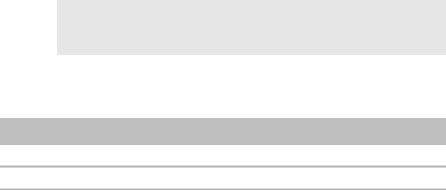
RH4xxLD, RH4xxLG |
Bestimmungsgemäßer Gebrauch |
•Überhitzungsgefahr!
Achten Sie stets darauf, dass beim Betrieb entstehende Wärme ausreichend abgeführt werden kann. Sorgen Sie dafür, dass das Gerät in ausreichendem Abstand zu Wänden oder Gegenständen steht, sodass die Luft zirkulieren kann.
•Achten Sie darauf, dass die Lüftungsöffnungen nicht abgedeckt werden.
•Füllen Sie keine Flüssigkeiten oder Eis in den Innenbehälter.
•Tauchen Sie das Gerät nie in Wasser.
•Schützen Sie das Gerät und die Kabel vor Hitze und Nässe.
•Achten Sie darauf, dass die Speisen keine Wand des Kühlraums berühren.
3Bestimmungsgemäßer Gebrauch
Das Kühlgerät eignet sich zum Kühlen von Getränken und Snacks.
Das Gerät ist für den Betrieb an einem 220 – 240 Vw-Wechselstromnetz ausgelegt.
!VORSICHT! Gesundheitsgefahr!
Prüfen Sie bitte, ob die Kühlleistung des Gerätes den Anforderungen der Lebensmittel oder Medikamente entspricht, die Sie kühlen wollen.
4Lieferumfang
Menge Bezeichnung
1Minibar
1Montageund Bedienungsanleitung
DE |
27 |
|
|
|
|

Technische Beschreibung |
RH4xxLD, RH4xxLG |
5Technische Beschreibung
Das Kühlgerät kann Waren bis maximal 21 °C (nur RH430LD, RH440LD, RH460LD) bzw. 18 °C (nur RH430LG, RH440LG, RH460LG) unter Umgebungstemperatur abkühlen und kühl halten. Durch ein Trenngitter können Lebensmittel getrennt werden, z.B. Flaschen und Süßigkeiten.
Bedienelement
Pos. in |
|
Abb. 1, |
Bezeichnung |
Seite 3 |
|
|
|
1Temperaturregler
Abtaufunktion
Auf den Kühlflächen bildet sich mit der Zeit eine Reifschicht. Um dies zu vermeiden, verfügt das Gerät über eine Funktion, durch die das Kühlaggregat alle 24 Stunden für zwei Stunden abgeschaltet wird.
Während dieser zweistündigen Abtauphase schmilzt die Reifschicht ab. Das entstehende Tauwasser läuft in einen Auffangbehälter unten an der Rückwand des Kühlschranks. Das Tauwasser verdampft von selbst, sodass der Auffangbehälter nicht manuell geleert werden muss.
6Montage
!WARNUNG! Stromschlaggefahr!
Nichtbeachtung dieser Hinweise kann zu Tod oder schweren Verletzungen führen.
•Stellen Sie beim Aufstellen des Geräts sicher, dass das Anschlusskabel nicht eingeklemmt oder beschädigt wird.
•Positionieren Sie keine Mehrfachsteckdosen oder Netzgeräte an der Rückseite des Geräts.
!VORSICHT! Gesundheitsgefahr
Um eine Gefährdung durch Instabilität des Gerätes zu vermeiden, muss dieses gemäß den Anweisungen befestigt werden.
28 |
DE |
|
RH4xxLD, RH4xxLG |
Montage |
Das Kühlgerät ist für die freistehende Verwendung gebaut. Es kann auch in ein Möbel eingebaut werden, wenn die folgenden Bedingungen erfüllt sind. Nur so sind ein optimaler Betrieb und eine maximale Kühlung gewährleistet.
•Das Kühlgerät muss sorgfältig ausgerichtet werden.
•Der Abstand zwischen der Rückseite und der Wand muss mindestens 20 mm betragen.
•Die Belüftung muss wie in den Alternativen A, B, C oder D realisiert sein (Abb. 2, Seite 3).
•Der Lüftungskanal muss einen Querschnitt von mindestens 105 mm x Breite des Kühlgeräts haben.
•Das Kühlaggregat muss komplett in den Lüftungskanal ragen. Andere Teile dürfen nicht in den Lüftungskanal ragen (Abb. 2, Seite 3).
•Die Luft, die durch den Lüftungskanal strömt, darf nicht durch eine andere Wärmequelle erwärmt sein.
•Es dürfen nur Lüftungsgitter (optional) verwendet werden, die eine freie Querschnittsfläche von mindestens 200 cm² aufweisen.
•Bei Varianten mit Glastüren kann Feuchtigkeit auf der Tür kondensieren, wenn die Luftfeuchtigkeit mehr als 65 % bei 25 °C beträgt.
•Das Kühlgerät muss befestigt werden. Verwenden Sie dazu Schrauben mit
geeigneter Länge, die durch die Befestigungsbohrungen in den Gerätefüßen geschraubt werden (Abb. 3, Seite 3).
•Die Steckdose, an der das Gerät angeschlossen wird, muss frei zugänglich bleiben.
6.1Dekorplatte austauschen
Sie können die Dekorplatte austauschen: Abb. 4 bis Abb. 7, Seite 4.
6.2Schleppbeschlag (optional) montieren
Sie können einen Schleppbeschlag montieren, mit dem sich die Tür des Kühlgeräts gleichzeitig mit der Tür des Einbauschranks öffnet: Abb. 8, Seite 5, bis Abb. m, Seite 8.
6.3Türanschlag wechseln
So wechseln Sie den Türanschlag: Abb. n bis Abb. r, Seite 9. Nur für Türen mit Schleppbeschlag: Abb. p und Abb. q, Seite 9.
DE |
29 |
|
|
|
|

Bedienung |
RH4xxLD, RH4xxLG |
7Bedienung
!VORSICHT! Gesundheitsgefahr!
Prüfen Sie bitte, ob die Kühlleistung des Gerätes den Anforderungen der Lebensmittel oder Medikamente entspricht, die Sie kühlen wollen.
IHINWEIS
•Bevor Sie das neue Kühlgerät in Betrieb nehmen, sollten Sie es aus hygienischen Gründen innen und außen mit einem feuchten Tuch reinigen (siehe auch „Reinigung und Pflege“ auf Seite 18).
•Einige Wassertropfen können sich im Inneren des Kühlgeräts absetzen, wenn es über einen längeren Zeitraum gekühlt hat. Dies ist kein Hinweis auf einen Defekt des Geräts. Die Feuchtigkeit in der Luft kondensiert zu Wassertropfen, wenn die Temperatur im Kühlgerät sinkt. Wischen Sie das Wasser ggf. mit einem trockenen Tuch auf.
7.1Tipps zum Energiesparen
•Wählen Sie einen gut belüfteten und vor Sonnenstrahlen geschützten Einsatzort.
•Lassen Sie warme Speisen erst abkühlen, bevor Sie sie im Kühlgerät kühl halten.
•Öffnen Sie das Kühlgerät nicht häufiger als nötig.
•Lassen Sie das Kühlgerät nicht länger offen als nötig.
7.2Kühlgerät benutzen
AACHTUNG! Beschädigungsgefahr!
•Achten Sie darauf, dass sich nur Gegenstände bzw. Waren im Kühlgerät befinden, die auf die gewählte Temperatur gekühlt werden dürfen.
•Achten Sie darauf, dass Sie Getränke oder Speisen in Glasbehältern nicht zu stark abkühlen. Beim Gefrieren dehnen sich Getränke oder flüssige Speisen aus. Dadurch können die Glasbehälter zerstört werden.
•Achten Sie darauf, dass das Kühlgerät gut belüftet wird, damit die entzogene Wärme abgeführt werden kann, andernfalls ist eine ordnungsgemäße Funktion nicht gewährleistet. Insbesondere dürfen die Lüftungsöffnungen nicht abgedeckt werden.
30 |
DE |
|
